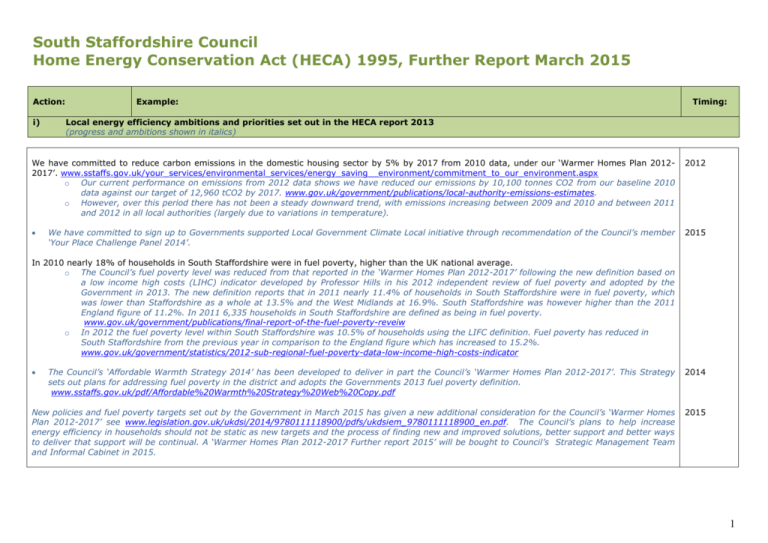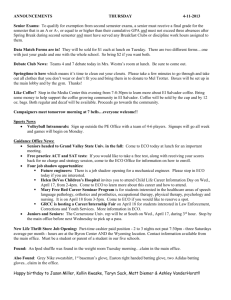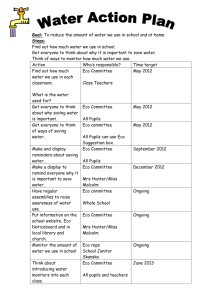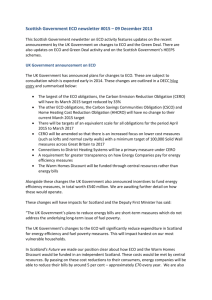Commitments and Actions - South Staffordshire Council
advertisement

South Staffordshire Council Home Energy Conservation Act (HECA) 1995, Further Report March 2015 Action: i) Example: Timing: Local energy efficiency ambitions and priorities set out in the HECA report 2013 (progress and ambitions shown in italics) We have committed to reduce carbon emissions in the domestic housing sector by 5% by 2017 from 2010 data, under our ‘Warmer Homes Plan 20122017’. www.sstaffs.gov.uk/your_services/environmental_services/energy_saving__environment/commitment_to_our_environment.aspx o Our current performance on emissions from 2012 data shows we have reduced our emissions by 10,100 tonnes CO2 from our baseline 2010 data against our target of 12,960 tCO2 by 2017. www.gov.uk/government/publications/local-authority-emissions-estimates. o However, over this period there has not been a steady downward trend, with emissions increasing between 2009 and 2010 and between 2011 and 2012 in all local authorities (largely due to variations in temperature). 2012 2015 We have committed to sign up to Governments supported Local Government Climate Local initiative through recommendation of the Council’s member ‘Your Place Challenge Panel 2014’. In 2010 nearly 18% of households in South Staffordshire were in fuel poverty, higher than the UK national average. o The Council’s fuel poverty level was reduced from that reported in the ‘Warmer Homes Plan 2012-2017’ following the new definition based on a low income high costs (LIHC) indicator developed by Professor Hills in his 2012 independent review of fuel poverty and adopted by the Government in 2013. The new definition reports that in 2011 nearly 11.4% of households in South Staffordshire were in fuel poverty, which was lower than Staffordshire as a whole at 13.5% and the West Midlands at 16.9%. South Staffordshire was however higher than the 2011 England figure of 11.2%. In 2011 6,335 households in South Staffordshire are defined as being in fuel poverty. www.gov.uk/government/publications/final-report-of-the-fuel-poverty-reveiw o In 2012 the fuel poverty level within South Staffordshire was 10.5% of households using the LIFC definition. Fuel poverty has reduced in South Staffordshire from the previous year in comparison to the England figure which has increased to 15.2%. www.gov.uk/government/statistics/2012-sub-regional-fuel-poverty-data-low-income-high-costs-indicator The Council’s ‘Affordable Warmth Strategy 2014’ has been developed to deliver in part the Council’s ‘Warmer Homes Plan 2012-2017’. This Strategy sets out plans for addressing fuel poverty in the district and adopts the Governments 2013 fuel poverty definition. www.sstaffs.gov.uk/pdf/Affordable%20Warmth%20Strategy%20Web%20Copy.pdf 2014 New policies and fuel poverty targets set out by the Government in March 2015 has given a new additional consideration for the Council’s ‘Warmer Homes Plan 2012-2017’ see www.legislation.gov.uk/ukdsi/2014/9780111118900/pdfs/ukdsiem_9780111118900_en.pdf. The Council’s plans to help increase energy efficiency in households should not be static as new targets and the process of finding new and improved solutions, better support and better ways to deliver that support will be continual. A ‘Warmer Homes Plan 2012-2017 Further report 2015’ will be bought to Council’s Strategic Management Team and Informal Cabinet in 2015. 2015 1 ii) measures we are taking to result in significant energy efficiency improvements of our residential accommodation We will develop and implement a Behavioural Change campaign within the district on energy efficiency and savings, including low carbon sustainable energy, focusing on those residents disengaged with energy issues, those in off gas areas and our most vulnerable residents. The aim being to reduce CO2 emissions from high carbon emission fuel usage and reduce fuel poverty. South Staffordshire Energy Advice Line (SSEAL) We have set up an advice line partnering with Marches Energy Agency to provide independent advice and facilitate all households to get the best deal on their energy bills and helping the most vulnerable households through telephone and face-to-face help focusing on, reducing energy costs and consumption, facilitating access to ECO and GD(HIF) and other local funding help, emergency heating help and also advising and facilitating both households and local businesses with renewable energy. The advice Line is supported by delivering face to face training and e-training, to the Council’s customer service, benefits and other frontline partners and workers such as county/district/parish members, fire service, housing associations, health care, voluntary and community organisations through our ‘Let’s Work Together’ partners, using local networks and knowledge to help reach some of the most vulnerable. www.sstaffs.gov.uk/energy Increasing household energy efficiency Case studies: o Mr D rang complaining his energy bills were extremely high and there seemed to be nothing he could do about it. When discussing switching energy supplier Mr D said “that he didn’t ‘switch’ as he felt it was not worth it because it was complicated and didn’t make any real difference”. SSEAL offered Mr D a tariff switching exercise and discussed the Warm Home Discount to make sure Mr D didn’t lose out by switching to a supplier not on the scheme. Mr D was advised about the less well-known energy companies that came up during the switching exercise. Mr D was happier staying with one of the big 6 companies and even so he was able to save £215 per year on his energy bills. This added to the potential saving of £60 a year from additional energy efficiency advice SSEAL gave him, an annual saving of £275 was achievable. Mr D said, “Thanks very much for that. It was much simpler than I expected and it really will save me money.” o Mr O was suffering from a serious heart condition and clinical depression. He was on benefits due to a long term sickness. His boiler was old and had broken down leaving him without heating or hot water. SSEAL organised emergency heating while they worked to access a number of pots of funding from several different sources which were put altogether to pay for a replacement boiler costing £2,240.39. Mr O now has a new boiler delivering a functioning heating system and hot water. His health outcomes are now greatly improved as is his depression after having a major worry removed. Asked to comment he stated that “I couldn’t be happier. This is amazing! Thanks for all your help” March 2014 2014/2015 2014 2014 2 Government and other initiatives The Affordable Warmth Strategy (2014-2017) The Strategy sets out the Council’s commitment to promote affordable warmth and South Staffordshire Council’s Energy Advice Line (SSEAL) to all households in the district. The strategy will help deliver the Council’s ‘Warmer Homes Plan’. The strategy focuses on developing, delivering, and monitoring initiatives that will help reduce fuel poverty and winter deaths in South Staffordshire. The strategy has developed a ‘Community Energy Efficiency and Reduction Plan’ Appendix 4 and a ‘Communications Energy Efficiency and Reduction Communications Delivery Matrix’ Appendix 5. see www.sstaffs.gov.uk/your_services/environmental_services/energy_saving__environment/commitment_to_our_environment.aspx These plans have set our priorities and seek to improve the targeting of our schemes using the Council’s bespoke customer insight data to identify key area messages and to tailor communication methods for the people in those areas and available initiatives. 2014 Your Place Challenge Panel 2014 The Council’s member ‘Your Place Challenge Panel 2014’ focused on, ‘Reviewing fuel poverty and energy efficiency in South Staffordshire’ looking at working with partners to identify vulnerable customers at risk of fuel poverty and promotion of energy efficient schemes, which resulted in the following recommendations: To support the South Staffordshire ‘Community Energy Efficiency and Reduction Plan and Communication Matrix 2013-2015’, developed with members and officers as part of the review. Promoting the energy advice line and current initiatives available. For elected members and officers to support one another when identifying vulnerable residents and signpost residents to the energy advice line. To review the pilot projects carried out under the ‘Warmer Homes Plan’, for accessing national initiatives to increase energy efficiency in the home. For South Staffordshire Council to sign up to the Local Government Association’s Climate Local initiative to demonstrate the Council’s commitment to helping to reduce the effects of our changing weather patterns on our most vulnerable residents. 2014 Government Initiatives: March 2013 We have secured funding through the Government’s Warm Homes Healthy People of £24,500 through a Staffordshire wide project to help reduce winter deaths and fuel poverty by promoting support and advice that is available through partners in the area. Project partners include Marches Energy Agency, Citizens Advice Bureau, Metropolitan Home Improvement Agency, Staffordshire Fire & Rescue Service, Staffordshire Community Council. We will facilitate energy efficiency measures to those residents identified through this project, to help access ECO funding where opportunities arise. We are presently investigating Government initiatives such as the emerging Green Deal (GD) & Energy Company Obligations (ECO), together with FIT’s and Renewable Heat Incentives to maximise opportunities for energy efficiency improvements in our residential accommodation. We will establish our role in the GD and ECO to include consideration as a combined ‘promoter/partner’ role. o South Staffordshire Council are investigating a combined ‘promoter/facilitator/partner’ role in Government’s Green Deal Ongoing 2012/2013 2014 3 (GD)/Energy Company Obligation (ECO) initiative. Reducing fuel poverty has been prioritised by the members ‘Your Place Challenge Panel 2014’ supported by the governments new Fuel Poverty Strategy Targets, March 2015. o As a result of our pilot project to access ECO, it was identified that we need to be flexible and take advantage of any new funding sources that develop. Presently this requires contacts/links to be developed with a variety of partners/deliverers/providers/installers/agencies, requiring no one commitment to one source considering the present instability in this market. Our role will continue to evolve as partnerships are developed. We will identify ambitions and priorities for targeting energy efficiency work for those residents in greatest need to access GD and ECO opportunities. o Tackling the low levels of energy efficiency in homes of the vulnerable and fuel poor is a priority, established through the work with the members ‘Your Place Challenge Panel 2014’ and set out in the ‘Affordable Warmth Strategy 2014’. Establishing our role in GD/ECO - Hinksford Park Homes External Wall Insulation Project 2013/2014 learning. o ECO doesn’t appear to prioritise need and address fuel poverty as the project has been shown that those most vulnerable couldn’t access ECO due to works to homes being required prior to having energy efficiency installs done which can’t be funded through ECO. The vulnerable can’t afford to pay for these works. The Council need to therefore consider support to the most vulnerable and find funding from other sources to top-up ECO/GD(HIF). Case study see www.sstaffs.gov.uk/your_services/environmental_services/energy_saving__environment/commitment_to_our_environm ent.aspx We will continue to investigate Government initiatives for support or funding, including any new schemes such as Community Energy Saving Competition, the Central Heating Fund and Fuel Poverty and Health Booster Fund, where opportunities arise and it is considered that this may help the Council deliver against the new fuel poverty strategy and it is cost effective and practicable. Staffordshire Resilience Communities – Winter Warmth Scheme. The Staffordshire wide project is a partnership of Local Authorities and Voluntary Sector Agencies. It will commence in November 2014 and will finish no later than March 2015. The project will aim to follow NICE guideline recommendations on how to reduce the risk of death and ill health associated with living in a cold home. www.nice.org.uk/guidance/ng6 South Staffordshire Winter Warmth Scheme. To help deliver the recommendations of the Council’s member ‘Your Place Challenge Panel 2014’ a project was developed together to help keep the most vulnerable households warm and well in the winter. The project aims to improve the health and wellbeing of residents who meet set criteria in our communities by improving the warmth of the home through low cost energy efficiency measures helping to reduce fuel poverty. Partnerships include county council, Staffordshire Fire and Rescue Service, district and county Councillors, energy companies, housing agency, Marches Energy Agency and Warmzones. www.sstaffs.gov.uk/your_services/environmental_services/energy_saving__environment/commitment_to_our_environment.aspx Ongoing 2014 2014/2015 Ongoing 2014 2015 & 2014 2015 & Our vision is to evaluate these schemes to learn from them and help develop future initiatives to realise our ambitions. Ongoing 4 Economic opportunities We will investigate the economic opportunities from energy efficiency measures and low carbon/sustainable energy such as small scale renewables/microgen & GD/ECO work for local installers/manufactures when exploring and developing opportunities and initiatives. Instability in the ECO has created difficulties for local installers so until there is stability in this area it is difficult to support local economic development. However the Council will continue to support local opportunities when investigating energy efficiency projects. We will explore & develop an Energy Champions Scheme for local residents to assist in the delivery of the above projects to engage local neighbours through trust and identify those most vulnerable residents in need of help. Energy Champions Energy efficiency assessment of housing March 2015 The Council’s member ‘Your Place Challenge Panel 2014’ established ‘Energy Champions’ through recommendations that: all members receive updates to ensure they are aware of the current schemes and initiatives available and where to signpost residents, an aide memoire will also be provided. elected members become advocates of the energy advice line and complete the online training to help identify vulnerable residents. key partners be made aware of and to promote the advice line and the current initiatives available, particularly to vulnerable residents. To ensure all new built homes are zero carbon by 2016 in accordance with the Local Plan (Core Strategy) for South Staffordshire. Before 2016, all new build homes must meet an element of energy requirements through the use of renewable energy technologies. This is evidenced by the work carried out as part of a Staffordshire wide consortium of local authorities, who have subsequently drafted householder guidance on Sustainable Construction and Renewable Energy. Zero carbon homes Ongoing 2013 We have an adopted Local Plan policy requiring Zero Carbon homes by 2016, however new government guidance, and changes to Building Regs that lessen the energy targets for new build, have been proposed that would need to be considered together with this policy should it come into effect. As a result of these proposed changes by the government, it is likely that the target date to reach Zero Carbon will be delayed. www.sstaffs.gov.uk/your_services/strategic_services/planning_policy_local_plans/core_strategy/the_adopted_core_strategy.aspx We will establish data on the energy efficiency rating of our residential accommodation in order to assess the potential of emerging initiatives, including carbon/sustainable energy such as small scale renewables/microgeneration, to deliver CO2 savings and economic benefits with local partner organisations. This data including EPC, FIT and RHI data at a local level will be used in part to establish the Council’s role in the Governments new Fuel Poverty Targets. Ongoing 5 Ongoing Minimum standards in the private rental sector iii) We are working with our local landlords to facilitate energy efficiency activity in the district and raise awareness of their legal obligation regarding Energy Performance Certificates (EPC’s). We will investigate with local partners and businesses, how we can support energy efficiency improvements in the private rented sector and the impact it would have on fuel poverty in South Staffordshire. Measures we propose to cost effectively deliver energy efficiency improvements in residential accommodation by using area based/street roll out. We will concentrate on maximising the benefits for our residents through the emerging ECO opportunities. South Staffordshire (SS) has no Lower Super Output Areas which fall into England’s 20% most deprived which are eligible for the ECO Carbon Savings Community Obligation (CSCO). However SS residents in private rented or owner occupied homes should be able to access energy efficiency measures funded through ECO Affordable Warmth where they qualify in the Super Priority Group (vulnerable) for insulation and heating improvements. Also all SS residents should be able to access ECO (CERO – Carbon Emission Reduction Obligation) for hard to treat walls which is not means tested and available for both private and social housing. We will identify ambitions and priorities for targeting energy efficiency work for the vulnerable in the private sector that fit into the ECO Affordable Warmth Group to access insulation and heating improvements. We will identify ambitions and priorities for targeting energy efficiency work for those residents in homes with hard to treat walls in both private and social housing to potentially access ECO (CERO) funding on an area based basis. Planning issues will also be considered. We will determine any partnership work with other energy efficiency work and other organisations. We will carry out pilot projects with partners, where able, to determine the accessibility to ECO funding for those residents prioritised above to obtain the benefits of early ECO funding. We will investigate with local partners our potential for area based energy schemes including any soft boundary access to neighbouring authorities CSCO schemes as GD and ECO emerge. 2013/2014 Area Based Pilot Project - Hinksford Park Homes External Wall Insulation Project 2013/2014 Hinksford Park has 137 park homes all privately owned and off gas. The project involving the local community and partners aimed to unlock ECO funding for vulnerable residents, maximising opportunities to increase energy efficiency of homes and reduce fuel poverty. Making homes warmer and healthier. Park Homes were identified as having a high proportion of home owners which are vulnerable to high fuel costs (electricity) due to increase with high effect. Many homeowners are elderly and have long term illnesses affected by a cold home and are in fuel poverty. Energy efficiency funding has previously been inaccessible for park homes through schemes such as CERT, CESP. Case study see www.sstaffs.gov.uk/your_services/environmental_services/energy_saving__environment/commitment_to_our_environment.aspx Ongoing March 2014 Energy Company Obligation (ECO) - In 2013/2014, 6 park homes were installed with external wall insulation bringing in £33,962 worth of funding from the energy companies. £21,110 was through ECO. Only 1 home was fully funded by ECO alone. This home is a larger/double home heated by electric storage heaters. Additional funding was identified through this project to top-up the ECO of £13,402 and £1,034 was from householders contributions. This top-up is means tested and cold effected health of residents tested. Some homes were fully funded through this 2013/2014 Ongoing 6 additional funding source. Larger homes were able to get fully funded ECO EWI due to their higher deemed energy bill savings leaving those fuel poor in smaller properties unable to access full funding. ECO delivery is based on carbon scores and not fuel poverty. This source of ECO is now inaccessible. Green Deal Home Improvement Fund (GD(HIF)) – in 2014/2015, 6 Park homes were installed with external wall insulation bringing in £26,693 worth of funding from the energy companies. £22,193 was through GD(HIF). No homes were fully funded by GD(HIF) and other top-up funding alone. Additional funding was identified through this project to top-up the GD(HIF) of £4,500 and £10,307 was from householders contributions. This top-up is means tested and cold effected health of residents tested. 2014/2015 Green Deal Cash Back (GDCB) – in 2014, 1 park home was installed with external wall insulation bringing in £6,675 worth of funding from the energy companies. £5,006 was through GDCB. This 1 home was fully funded by GDCB and other top-up funding alone. Additional funding was identified through this project to top-up the GDCB of £1,669. This top-up is means tested and cold effected health of residents tested. 2014 Total funding for park homes insulation achieved to date from national and local initiatives in 2014 up to March 2015 - 13 Park homes were installed with external wall insulation bringing in £63,503 worth of funding from the energy companies. £43,828 was through ECO, GD(HIF) and GDCB. Only 3 homes were fully funded. Additional funding was identified through this project to top-up the ECO, GD(HIF) and GDCB of £19,675. GD(HIF) March 2015 – 18 additional homes are awaiting funding for the installation of solid wall insulation from this initiative which would bring in an additional £67,500 and potentially additional top-up funding to help homeowners. Park Homes Case study - Residents were instantly warmer in their park homes following the install of external wall insulation. Mrs 1 commented “she had to turn the heating off and had to wear just a T-shirt which had never occurred in March over the 15 years she had been living in the property”. Mr 2 another home owner was in tears as he explained the difference having a warmer home would make to him and his wife who had a long term illness. One homeowner expressed their thanks to the Council as it was the best thing that the Council had ever done for them. District Heating Feasibility study for Hinksford Park Home Site - A survey was funded by an energy supplier in 2013 to assess the feasibility of providing energy efficiency measures which could be funded under ECO. The properties were surveyed to assess the suitability of a biomass fuelled district heating system together with other energy efficiency installs. The site was proven suitable for a district heating solution. Internally it was proposed to install heat interface units to provide domestic hot water and space heating via a new wet distribution system (radiators). Heat meters and a remote billing facility would have been incorporated into the installation together with external wall insulation. The project was proposed to be delivered through a joint and collaborative approach by the energy company, installer company, South Staffordshire Council and Marches Energy Agency to ensure the scheme is successfully delivered in 2014. Unfortunately this project did not go ahead as the ECO funding was withdrawn following changes to ECO delivery. Vision for future work where opportunities arise. We will explore the scope to build upon our recent activity to support the fuel poor living in the off gas park home sites supported by the Council’s member ‘Your Place Challenge Panel 2014’, by: Continuing investigation into opportunities as they arise for a whole site energy efficiency project. extending consideration to the role that local Health and Wellbeing Boards and local health partners, and local economic development where able to help the fuel poor. Building on our success in attracting ECO, GD(HIF) and other sources of top-up funding for park homeowners to increase the number of installs of 2014/2015 2015 2014 2013 2015 onwards 7 solid wall insulation where opportunities arise. supporting the local community and homeowners to act as advocates, driving demand by others seeing the work being carried out and what can be achieved on neighbouring properties, and the resulting benefits evaluating health and wellbeing and try to quantify the potential cost savings to health and social care services from delivering energy efficiency measures to vulnerable park homeowners where opportunities arise. Continue investigating the upgrading of heating systems of park homeowners, together with area based heating systems using alternative energy sources such as biomass where opportunities arise. Investigate how we can increase our understanding of the impact of living in cold homes and fuel poverty through our Energy Advice Line service to enable homeowners’ access to a number of partner services addressing a broad range of health and wellbeing issues with one point of call. Continuing to help homeowners to manage their energy costs, better understand their heating systems and controls through our Energy Advice Line services and helping to reduce their energy bills, or switch tariffs. Our vision is to ensure that homeowners on park home sites in South Staffordshire are able to keep warm and comfortable in their homes, providing a healthy and welcoming environment that fosters well-being by facilitating the reduction in energy bills in the coldest low income homes. We will continue to investigate Government initiatives for support or funding, including any new schemes such as Community Energy Saving Competition, the Central Heating Fund and Fuel Poverty and Health Booster Fund, where opportunities arise and it is considered that this may help the Council deliver against the new fuel poverty strategy and it is cost effective and practicable. iv) Time frame for delivery and national and local partners ongoing We are working with Staffordshire County Council, Marches Energy Agency and other local energy agencies, Staffordshire Community Council, local community groups, local landlords, social housing partners, Metropolitan Home Improvement Agency, other local authorities and partner organisations to deliver the above. Our recent work has developed relationships with key local partners including, social housing providers, local businesses, voluntary/community organisations and county/district/parish councils and members including our ‘Let’s Work Together’ partners. http://www.southstaffordshire.thegoodlife.uk.net/south-staffs-partnership.html To realises our ambitions we will also aim to develop relationships with LEP, local businesses, health organisations where we can. 8









